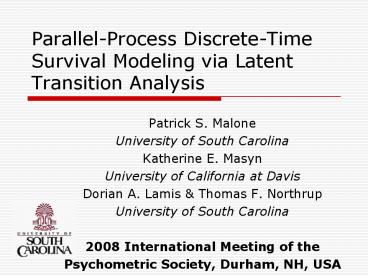Parallel-Process Discrete-Time Survival Modeling via Latent Transition Analysis - PowerPoint PPT Presentation
1 / 21
Title:
Parallel-Process Discrete-Time Survival Modeling via Latent Transition Analysis
Description:
Ann B. Brewster, Research Scientist. Duke/NIDA Transdisciplinary ... Process B. Logit(hT [B]) = 3T 4 I[AT-1] 5 Z. Notes: Time-invariant Lag-1 Model ... – PowerPoint PPT presentation
Number of Views:141
Avg rating:3.0/5.0
Title: Parallel-Process Discrete-Time Survival Modeling via Latent Transition Analysis
1
Parallel-Process Discrete-Time Survival Modeling
via Latent Transition Analysis
- Patrick S. Malone
- University of South Carolina
- Katherine E. Masyn
- University of California at Davis
- Dorian A. Lamis Thomas F. Northrup
- University of South Carolina
- 2008 International Meeting of the
- Psychometric Society, Durham, NH, USA
2
Acknowledgments
- Center for Child and Family Policy
- Ken Dodge, Director
- Ann B. Brewster, Research Scientist
- Duke/NIDA Transdisciplinary Prevention Research
Center - Susan G. Alexander, Director
- National Institute on Drug Abuse P20 DA017589-02
- Prevention Science and Methodology Group
- C. Hendricks Brown, PI
- National Institute on Mental Health and NIDA R01
MH40859
3
Acknowledgments
- Sample data drawn from the study entitled,
- Fast Track/ Multi-Site Prevention of
Adolescent Problem Behaviors, Conduct Problems
Prevention Research Group - Supported by the following grants
- National Institute of Mental Health (NIMH) Grants
R18 MH48043, - R18 MH50951, RH18 MH50952, and R18 MH50953
- The Center for Substance Abuse Prevention and the
National Institute on Drug Abuse also have
provided support through a memorandum of
agreement with the NIMH - Department of Education Grant S184U30002 and NIMH
Grants K05MH00797 and K05MH01027 also supported
the study.
4
Objectives
- To outline a model for Discrete-Time Survival
Analysis using Latent Transition Analysis - To extend that model to parallel DTS processes
- To show a worked example from field data
- To describe simulation research on a
parallel-process model
5
Discrete-Time Survival Analysis
- Time-to-Event Model
- Fewer occasions of measurement than events
- Appropriate for the first occurrence of an event
- Onset of Problem Behavior
- High School Dropout
- Divorce
- Death
6
DTSA via Latent Transition Analysis
Time 0
Time 1
Time 2
Time 3
Post-event
Post-event
Event
Pre-event
Event
Event
Pre-event
Pre-event
Pre-event
7
Parallel-Process DTSA
- Two time-to-event processes
- Measured concurrently
- Event hazard probability of Process A dependent
on past event status of Process B, and vice-versa - Not a competing-risks model both events can
occur
8
Parallel-Process Model
Time 0
Time 1
Time 2
Time 3
Post-event
Post-event
Event
A
Pre-event
Event
Event
Pre-event
Pre-event
Pre-event
Post-event
Post-event
Event
B
Pre-event
Event
Event
Pre-event
Pre-event
Pre-event
9
Parallel-Process Model
- Process A
- Logit(hTA) ß0T ß1 IBT-1 ß2 Z
- Process B
- Logit(hT B) ß3T ß4 IAT-1 ß5 Z
- Notes
- Time-invariant Lag-1 Model
- Proportional Hazard Odds
10
Example Dataset
- Data derive from Fast Track, a comprehensive,
multi-site investigation of the development and
prevention of conduct problems (CPPRG, 1992
Lochman CPPRG, 1995).
11
Sample
- 446 youth in control condition of Fast Track
- Identified as high risk on basis of upper-decile
behavior problems in kindergarten classes (3
kindergarten cohorts) - 48 African American
- 34 female
12
Outcome Measures School Dropout
- Collected annually (Spring) from school records
of last known school - Detailed reasons for missing data
- Either dropped out or ran away coded as
dropout - Other codes (e.g., could not locate record)
coded as missing - Detailed data available only for grade 8ff
(cohort 3), grade 9ff (cohort 2), grade 10ff (all
cohorts) - Remainder missing by design
13
Outcome MeasuresIllicit Substance Use
- Collected annually (Summer) from child
self-report - Any reported use of marijuana, cocaine,
non-prescribed medications, or other drugs
(other than alcohol and
tobacco) - Detailed data available for grade 4ff (all
cohorts)
14
Covariates
- Ethnicity (African American vs. other)
- Sex
- SES (Hollingshead)
- Site (four sites)
- Cohort
- Absenteeism (grade 3)
- Grades (grade 3)
15
Outcome Descriptives
16
Results
- Estimated in Mplus v5.1 (Muthén Muthén)
- First dropout is significantly predicted by
prior-year drug use - logistic b 1.09, SE 0.46, z 2.37
- hOR (95 CI) 2.96 (1.21, 7.26)
- First illegal drug use may be negatively
predicted by prior-year high school dropout, but
very large confidence interval - logistic b -2.32, SE 1.23, z 1.89
- hOR (95 CI) 0.10 (0.01, 1.09)
17
Findings
- The parallel-process survival model is a valuable
extension to work with time-to-event models. - Neither survival process is prioritized in the
methodology thus, able to tease apart
directionality (effectively a cross-lagged panel
survival analysis). - This model is also extensible to mediating and
moderating processes e.g., drug use may mediate
link between parental monitoring and dropout, or
parental monitoring may weaken the link between
illegal drug use and high school dropout.
18
Simulation Study 1
- Logit(h TA) ß0 ß1 IBT-1 ß2 Z
- Logit(h TB) ß3 ß4 IAT-1 ß5 Z
- Vary ß0, ß1, ß3, ß4, N
- ß2 ß5 0
- Large sample size needed
19
Simulation Study 2
- Logit(h TA) ß0 ß1 IBT-1 ß2 Z ß6 X
- Logit(h TB) ß3 ß4 IAT-1 ß5 Z ß7 X
- Examine distribution of products
- ß6 ß4
- ß7 ß1
20
Limitations and Implications
- Difficult to implement long time-spans
- Work with software authors to reduce computing
limitations - Distribution of product of effects plausibly
guessed, but not known - Simulation work to explore properties of model
- Simulation work to establish applicability of
asymmetric empirical confidence interval for
indirect effects
21
For further information
- Patrick S. Malone
- malone.ps_at_gmail.com































